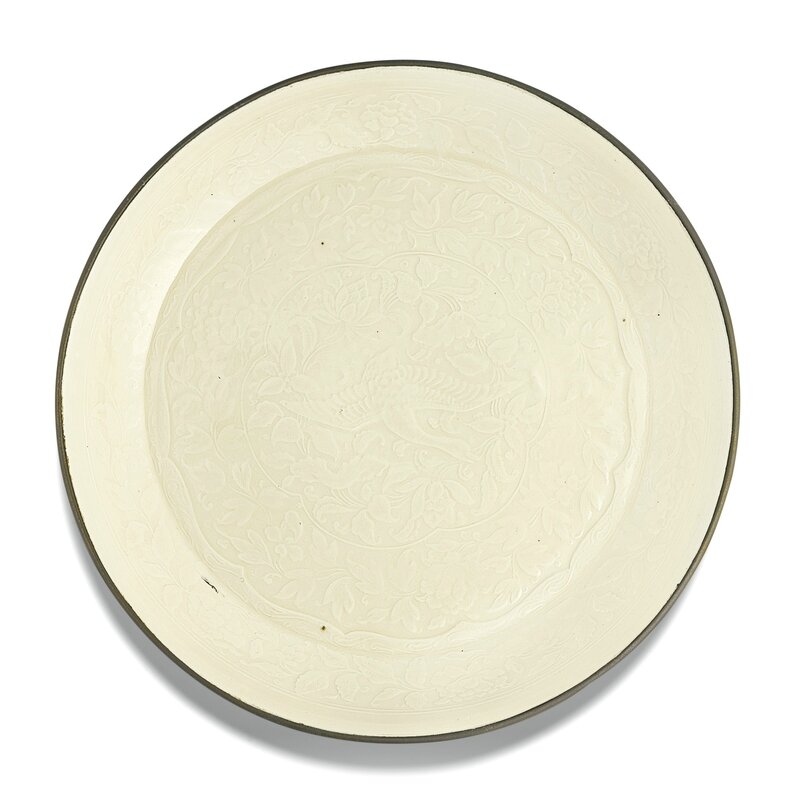A 'Ding' moulded 'goose' dish, Northern Song-Jin dynasty
Lot 31. A 'Ding' moulded 'goose' dish, Northern Song-Jin dynasty; 18.2 cm, 7 3/8 in. Estimate 50,000 — 60,000 GBP (63,855 - 76,626 EUR). Lot sold 221,000 GBP (279,897 EUR). Photo Sotheby's.
the foliate-shaped centre of the shallow, flat-bottomed dish finely moulded with a flying goose with its wings outstretched and feathers carefully delineated, surrounded by a wreath of lotus, tightly enclosed within a hexalobed border with encircling scroll of tree peonies, the everted rim crisply moulded with peonies borne on a leafy vine with small buds, applied overall with an ivory glaze with characteristic teardrop streaks running down the exterior, metal bound rim.
Provenance: Sotheby's New York, 31st March 2005, lot 35.
Exhibition: Anthology of Chinese Art, Min Chiu Society Silver Jubilee Exhibition, Hong Kong Museum of Art, Hong Kong, 1985, cat. no. 127.
Min Chiu Society Thirtieth Anniversary Exhibition, Hong Kong Museum of Art, Hong Kong, 1990, cat. no. 89.
Notes: This dish is a fine example of moulded Ding ware, where the intricate design of a goose flying amongst flowering branches has been rendered with remarkable depth and clarity and covered in a delicate ivory-coloured glaze. Production of Ding ware consisted mostly of small utilitarian wares such as dishes and bowls initially left undecorated or hand carved in the 10th to 12th centuries. From the late Northern Song period, craftsmen moved away from incised decoration to using mushroom-shaped moulds which were similar to those used for casting gold and silver vessels. The clay was pressed onto the relief-decorated mould before the edges were trimmed down to ensure the piece retained the form as well as the thinness and lightness of precious materials. This technique allowed for the manufacture of a large number of vessels, thereby satisfying the demand of the market.
Dishes of this form with such crisply-moulded bird and flower motifs are rare and are more commonly known with less detailing, such as two dishes with everted rims, in the National Palace Museum, Taipei, decorated with birds among flowers, published in the Illustrated Catalogue of Sung Dynasty Porcelain in the National Palace Museum. Ting Ware and Ting-type Ware, Taipei, 1973, pls 66 and 67; another, from the collection of the Ashmolean Museum, Oxford, illustrated in Jan Wirgin,Sung Ceramic Designs, Stockholm, 1970, pl. 100b; and two further examples sold in these rooms, the first, from the collections of Major M.H. Soames and G.A. Kolkhorst, 29th June 1954, lot 14, and again, 17th February 1959, lot 60, and the second, 26th April 1966, lot 21. See also a dish moulded with a related design, but modelled with a barbed rim, in the Museum of Oriental Ceramics, Osaka, included in the exhibition Song Ceramics, Tobu Museum of Art, Tokyo, 1999, cat. no. 31.
The motif on this dish also reveals the influence of precious materials on Ding wares, as it bears a resemblance to contemporary silver ware and brocaded textiles. Rose Kerr, in Song Ceramics, London, 1982, p. 102, remarks that Ding ware had a ‘tendency to mimic other, more precious materials such as gold and silver, huge quantities of which were stored in palace treasuries’. Compare for example a silver dish with barbed rim, decorated with two geese amongst lotus flowers, in the Jiangxi Provincial Museum, Nanchang, illustrated in Zhongguo jin yin boli falangqi quanji, vol. 2, Shijiazhuang, 2004, pl. 216 (right). See also a fragment of a kesi tapestry decorated with a cartouche enclosing a bird amongst flowers in the British Museum, London, illustrated in Shelagh Vainker, Chinese Silk. A Cultural History, London, 2004, pl. 84.
Sotheby's. Important Chinese Art Londres, 11 mai 2016, 10:00 AM

/https%3A%2F%2Fprofilepics.canalblog.com%2Fprofilepics%2F1%2F0%2F100183.jpg)
/https%3A%2F%2Fstorage.canalblog.com%2F03%2F02%2F119589%2F96711876_o.jpg)
/https%3A%2F%2Fstorage.canalblog.com%2F11%2F31%2F119589%2F94773502_o.jpg)
/https%3A%2F%2Fstorage.canalblog.com%2F20%2F83%2F119589%2F94772815_o.jpg)
/https%3A%2F%2Fstorage.canalblog.com%2F26%2F72%2F119589%2F75604929_o.jpg)
/https%3A%2F%2Fstorage.canalblog.com%2F59%2F60%2F119589%2F26458628_o.jpg)



/http%3A%2F%2Fstorage.canalblog.com%2F99%2F20%2F119589%2F128975976_o.jpg)
/http%3A%2F%2Fstorage.canalblog.com%2F67%2F27%2F119589%2F128312691_o.jpg)
/http%3A%2F%2Fstorage.canalblog.com%2F57%2F26%2F119589%2F128308274_o.jpg)
/http%3A%2F%2Fstorage.canalblog.com%2F69%2F24%2F119589%2F128072535_o.jpg)